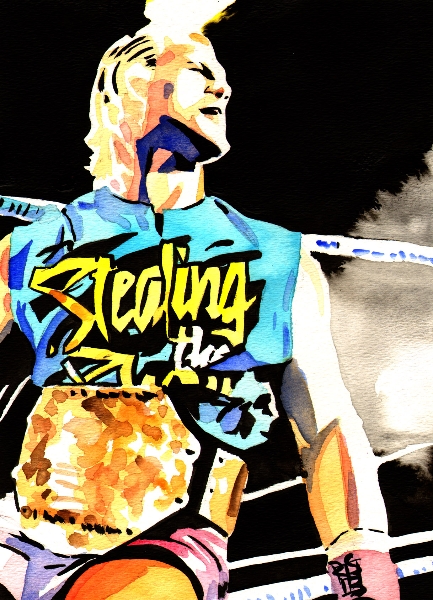Matt Murphy- Welcome to Wrestling
Posted by flairwhoooooo on October 5, 2009

1. Welcome to Wrestling
As a former instructor at the Harley Race Wrestling Academy, I could write an entire book about some of the goofy things I’ve seen and heard from aspiring wrestlers. From being asked, “How long do you have to train before you get to WWE?” to seeing a 110-pound kid sit up like the Undertaker after each bump, I’ve realized that this industry attracts its share of goofs.
Don’t be that guy.
For those who dream of becoming a wrestler, the first step is to ask yourself, Why? Is it because you were a dork in high school and you want to be the darling of your class reunion? If so, then this probably isn’t the business for you. Not too many dorks successfully overcome that stigma by wearing spandex. Is it because you watch it on TV, subscribe to a newsletter, and can name every Ring of Honor World Champion in the title’s history? A lot of people are like that: they’re called “fans.” I love St. Louis Cardinals baseball, but I know that I best benefit the team I love by watching their games on TV, buying a ticket to attend a game on occasion, and wearing their apparel as often as is acceptable for a grown man. A lot of wrestling hopefuls also belong in the cheap seats.
Next, look into a mirror and ask, Is there anybody making a living in the business that looks like me? If your answer is Don West (the TNA color commentator), then maybe you should consider another end of the business to enter. Most of the people who try out for wrestling don’t look anything like a wrestler, or even like an athlete for that matter. I can’t tell you how many times I’ve seen the “Athletic Background” section of the tryout application left blank.
Now evaluate the kind of shape you’re in and be honest. Wrestling is a physical sport that requires excellent conditioning. You don’t have to look like a bodybuilder to have a chance at stardom, but you do need to look like an athlete in very good shape. If you’re not in shape when you enter a wrestling school then you’ll lose a lot of valuable training time to conditioning while holding up the rest of the class.
There are exceptions to the rules. Fellow Harley Race Academy graduate Trevor Murdoch was one of them. Like me, he worked harder avoiding a gym than he would’ve worked lifting, but he worked his ass off inside the ring. Mick Foley looks like a truck driver, but he became a much bigger star in the business than anybody would have expected. Those are very, very rare occurrences. Don’t bank on being the next exception.
Don’t get me wrong. If you’re a 165-pound man with a beer belly and a checking account, there are still con men out there who will train you. If you have money, somebody will make time for you. But I don’t know anybody willing to do that who knows enough to give you the tools to have a chance in this business. Every day, a new fool latches on to the dream of wrestling stardom who looks for the cheapest wrestling school he can find. If I need to explain why this is a terrible way to pursue your dream, please stop reading now. There’s nothing I can write that can save a lost cause. Go get trained at Jacob Jabroni’s Discount Wrestling University, get your wrestling license, and book a “How Do You Like Me Now” show in your hometown so you can move on with your life.
Before jumping into this business with both feet, evaluate your financial situation. I love the business, you might say, but I can’t get enough money saved to begin training. If you love this business and want to be a part of it, then get a job, or a second job, or change your spending habits. Nobody gets a free ride. If you can’t show your dedication to this business by preparing yourself financially, then you don’t have a chance. Is it all about money? Well, it’s a business and people have to eat. Your instructor won’t call his electric company and say, “I can’t pay my bill because there’s a new kid I’m training who doesn’t have any money. He’s a good kid, though.”
If you’ve been honest with yourself and still think you have a chance at becoming a star in the business, start looking for a wrestling school. A good rule of thumb is if you have never heard of the guy running the school or of any of his students, don’t go there. If there is no tryout and the only requirement is money, stay away from that one, too.
Just a few days before I began training at the Harley Race Wrestling Academy, an independent wrestler approached me and tried selling me on his school. “How much is Harley charging you?” he asked me.
“Three thousand,” I told him.
The guy whistled and said, “Why pay three grand to be trained by Harley Race when you can be trained by me and my partner for half that?”
Even as young as naive as I was, I knew that it didn’t add up: I’d never heard of him or his partner. I chose to pass on his half-priced, half-assed training offer and recommend you do the same.
There are a handful of guys who have credibility and connections in this business. Maybe the two most important things to consider when making your wrestling-school choice are credibility and connections.
You’ve made a wise decision and selected a credible wrestling school. Now it’s time for the tryout. This will usually consist of cardiovascular exercise and in-ring evaluation (likely just bumps and running the ropes, so resist the urge to offer to show the instructor the badass finishing move you’ve been practicing on your pillow) and, at the Harley Race Wrestling Academy, costs $50. That’s a small investment in your dream.
First things first, don’t act like a tool. Be courteous and don’t act like a fan who won a backstage pass to a WWE show. Don’t ask wrestlers if they use blood capsules (they don’t), brag about your backyard heroics, talk about how many fights you’ve won, or act like you know any more about the business than the average fan. As a trainer, few things were as annoying as listening to the tryout talk about who he thought had the best workrate. Don’t do anything unless you’re instructed and don’t speak unless spoken to. It sounds harsh, but you don’t want to piss off the trainers before you even begin training, especially when they are the ones who decide just how far to push you during your tryout.
As a general rule, I knew almost every person trying out would reach that point where he didn’t think he could push himself any more. What I looked for was how much heart he showed when he reached that point.
Here is a tale of two tryouts. One kid was about 6’2” and 115 pounds and had no athletic ability at all. It didn’t take long for him to reach his breaking point, but I’ll be damned if he didn’t struggle to his feet—the poor guy looked like a baby giraffe trying to stand for the first time—each time he fell. I couldn’t pass him on the tryout because I didn’t think it would be fair to take his money when I knew he would never make it through training, but I admired his courage and would have passed him if I thought he had a chance in hell. Another tryout that day was a bodybuilder and former collegiate football player. Ten minutes into his tryout, he stumbled over to his duffel bag and said, “Sorry, guys, I just can’t do it.” On the street, he would have looked down at the baby giraffe kid, but inside the wrestling school that day, the skinny kid owned him.
Unlike most athletes, I was a cigarette smoker from my early teens to just a few months ago. I quickly figured that out the key to surviving cardiovascular exercise (and later on, long matches) was to control my breathing. Here’s how I learned: when I did jumping jacks, I inhaled slowly through four jumping jacks and exhaled slowly through four of them, then repeated. I did the same with crunches, squats, and just about every other exercise. Within a week, I trained my body to control its own breathing without requiring any conscious thought and went from flat on the floor after ten minutes of cardio to making it the entire way through conditioning with little problem. It happened almost instantly.
If you have to vomit, do it in the appropriate place and then wash your mouth out and get back in line for cardio. It lets the trainers know that you’re serious about training. A trainer’s job in the tryout process is to weed out those who don’t have the heart, the ability, or the respect for the business.
Remember that by trying out, you are not only auditioning for a spot in a professional wrestling school, but you are trying to convince the trainer that you’re worth the risk of his credibility. He knows that if you’re likely to quit after three weeks and then market yourself as one of his students, the next guy who comes along with the trainer’s name attached to him will suffer.
Once you’ve made it through your cardiovascular part of the tryout, it’s time to step into the ring. Let me stress one point: if you are instructed to take a German suplex, power bomb, backdrop, etc., from somebody during your tryout, thank everybody for their time and leave. I’m dead serious. Wrestling is a dangerous profession, and any trainer who has no regard for your safety is not somebody you want to trust with your physical well-being. One bad bump can cripple, even kill.
The only bumps you should take during a tryout are back bumps and, depending on how you do with back bumps, maybe some front bumps (front flips to your back).
You may receive a brief introduction to hitting the ropes and locking up with an opponent, perhaps even learn a few holds. That should be about all you do during your tryout.
Now you’ve completed the tryout and it’s time to have a sit-down with the trainer to discuss what’s next. He’s going to want to know what your schedule looks like (when you can train), whether you’ll commute or relocate, and if you can pay in full or if payment arrangements will need to be made. I know I already said this, but please believe that this is a business and nobody is going to train you out of the goodness of his heart—I won’t. Training you requires an enormous time commitment, and I won’t spend a minute away from my family if I’m not getting paid for it. There is also building rent, equipment maintenance, insurance, etc., to consider. I’ve seen a lot of people dive into training with an empty wallet, and they don’t last long.
You’ve passed the tryout, made a down payment, and enrolled into a professional wrestling school. Great job! Now pat yourself on the back and tighten the laces on your gym shoes, because you’re in for one hell of a ride!
NEXT WEEK: Chapter 2: Training
If you missed last weeks Matt Murphy’s first installment Introduction go here









Silver 6ix said
Mr. Murphy has some of the sagest advice I’ve ever read with regard to attending a wrestling school. I began training in January, 2009 at the Harley Race Wrestling Academy as a referee, and the hardest lesson for me to learn was to keep my mouth shut. It really doesn’t matter that I’m 40 years old and have been watching wrestling at least 35 of those years; no one wants to hear my opinion about what’s best or what looks good in the ring.
There are so many things on this side of the business that I never knew before, but the trainers and Mr. Race know how to instruct those things and how to implement them in the ring to get the crowd exactly where they want them. Furthermore, Mr. Race’s wrestling school is second to none as far as instruction and safety. I’ve had the opportunity to work with some wrestlers over the last few months that weren’t trained in Mr. Race’s school, and the difference is night and day.
But if you make it past the tryout and enroll, it truly can be the ride of your life!